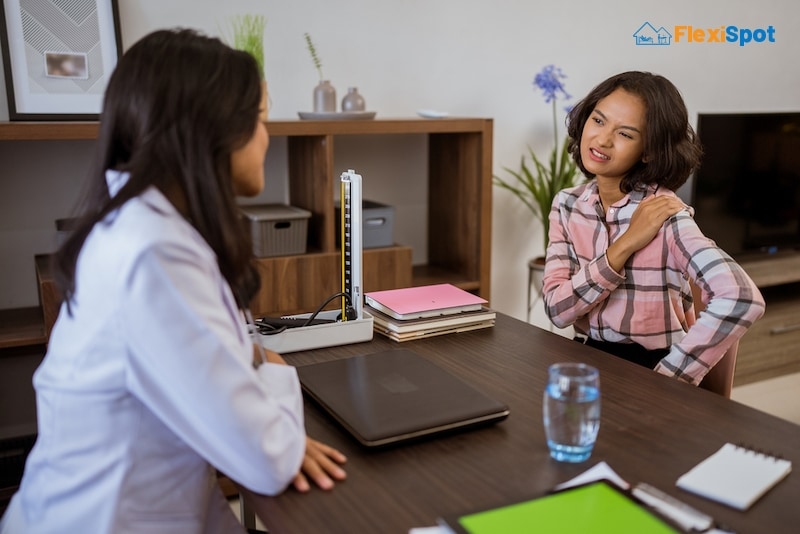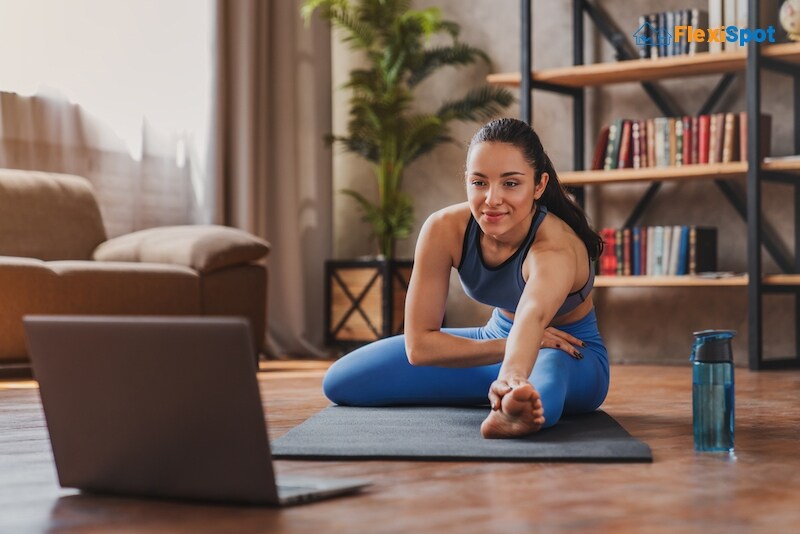It’s not just being on the foot that can tire you out. Sitting in the same posture for too long can have a more severe impact. Sitting in front of your computer, slumped forward, and typing at the keyboard all day long can be exhausting. You may not feel tired in a day, but the effects start surfacing over a long period. And when they do, the damage has already begun.
Not many workplaces are designed keeping ergonomics in mind. Employers tend to savethemselves the trouble and get the same equipment, such as chairs and tables,for everyone . While it makes an office space look coordinated and presentable, it fails to meet the ergonomic needs of the employees. As a result, the employees are at a higher risk of developing Musculoskeletal Disorders (MSD).
Since there’s not much you can do to change the nature of your job, what you can do is stretch every few minutes. Experts suggest you get up from your desk, stretch a bit, walk around, and let your muscles loosen up a bit after being seated in your chair for a while.
If you want to understand ergonomics better and see how stretching at work can help you prevent the consequences of sitting for a long duration, this blog post is just what you’ve got to read.
Why is Sitting for Long Hours Harmful for Your Health?
Before we talk about ergonomics and stretching between work, you’ve first got to understand why sitting for long hours is so dangerous and what harm it can do.
Neck and Shoulder Pain
When you’re sitting in your seat, hunched forward, and typing at the keyboard all day, you’re basically inviting harm upon yourself. This is the exact posture you shouldn’t be sitting in. When you sit in the wrong posture for long hours, your muscles will get stiff, and you’ll feel pain in your neck and shoulders. If you don’t do anything about it in time, the pain will become unbearable, keeping you from working efficiently.
Varicose Veins
When you’re sitting for extended durations, the blood starts to pool in your lower extremities. This can lead to the development of Varicose veins. Although the condition itself isn’t dangerous, it can lead to the formation of blood clots, which can further cause serious complications like Deep Vein Thrombosis (DVT). It’s a clot in the leg, but it can travel elsewhere in the body and lead to medical emergencies like pulmonary embolism, heart attack, and even death.
Heart Diseases
Sitting all day means you aren’t getting engaged in healthy physical activity as much as you should, like walking, running, or stretching. Lack of physical activity will reduce your physical strength and endurance and make your muscles weak. The worst consequence is a weak heart and an increased risk of heart conditions.
Back Pain
When you’re in a sitting position, most of your body weight is on the muscles of the lower back, which puts them under stress. The stress on the muscles is higher if you’re sitting in an incorrect posture. This can lead to severe back pain that doesn’t go away with painkillers.
Weight Gain
When you’re at work, you don’t walk around much after lunch or snacks that would burn the calories you consume during the day. Due to the lack of physical activity, the rate of digestion is affected. Your food isn’t digested as fast as it should, and you retain the sugars and fats. You know the rest – you start gaining weight.
Understanding the Physiology
Sitting for extended periods puts you at a higher risk of developing Musculoskeletal Disorders (MSD). Your body comprises numerous muscles, tendons, and nerves. When you sit in one posture (and that too, incorrectly), the muscles, tendons, and nerves of your body are constantly under stress. The muscles and nerves of the lower back are compressed more than they should be compressed, and the muscles and tendons of your shoulder and neck are continuously contracting to keep your body upright. When the stress is prolonged, the damage is long-lasting. The signs of MSD will start to appear, first as basic as back and neck pain and then exacerbate enough to impair your ability to sit and walk without feeling excruciating pain.
The most common MSDs that are reported in working individuals who’re sitting at their computers from 9 to 5 include tendonitis, Carpal Tunnel Syndrome, ligament sprain, and muscle strain.
This is the reason experts suggest employers invest in ergonomic office equipment. Sit-to-Stand work desks and ergonomic chairs like Ergonomic Office Mesh Chair 1368 ensure that employees who’ve to work on their computers all day aren’t at the risk of developing MSD.
While ergonomic office equipment is the best way to combat the consequences of prolonged sitting, stretching can also prevent all these physiological problems. You should take breaks from work and stretch after every 30 to 45 minutes.
How Does Stretching Help?
We completely understand the fact that one just can’t gather the strength to exercise after going home from a long day at work. However, you’ve got to understand that staying active when your job doesn’t allow you to is extremely crucial for your health. Stretching is one form of exercise that you can do while at work. Stretching offers numerous benefits, which is why it is highly recommended by physicians.
Helps Reduce Muscle Fatigue
One of the major reasons why you feel pain in the back, neck, and shoulders following long episodes of sitting is muscle fatigue. Since your muscles are in a constant state of physical inactivity, they’re bound to weaken. As a result, you’ll feel tired, and your body will pain even after the slightest of activity. However, stretching prevents all of that. It improves the blood flow to your muscles, thereby delivering the nutrients to the tissues and joints to keep them healthy and fit. It enhances the elasticity of muscles and tissues. Moreover, stretching also increases the natural lubricant of the joints (synovial fluid) that enhances the range of motion that enables you to do more strenuous activities without consuming too much energy. It also reduces the tightness and stiffness of the muscles and tendons. In short, stretching keeps your muscles, tendons, and tissues warm and active.
Improves Posture
Incorrect posture and poor ergonomics is the leading cause of MSD in working individuals. The spine and soft tissue structures become misaligned due to sitting in an incorrect posture for too long. The soft tissues adapt to your posture. Once they adapt to the wrong posture, restoring the right posture may feel painful. However, stretching is a very gentle form of exercise that helps realign these structures and ensure that you’re able to maintain the correct posture.
Aids Enhanced Muscle Coordination
When you stretch, the time an impulse takes to travel all the way to the brain and then back to the muscles is fairly reduced. This is known as the nerve impulse velocity. The higher the nerve impulse velocity, the better will be the muscle coordination and shorter will be the muscle response time. If you take stretching breaks every 30 to 45 minutes at work, the coordination between opposing groups of muscles will improve, and you’ll feel more active. The balance of your body will be greatly improved too.
How Often Should You Stretch?
Now that you know the plenty of ways stretching helps you, you may want to know how often you should stretch at work and for long. Ideally, you should take a stretch break every 30 to 45 minutes of working. According to experts, you should stretch for at least 5 to 10 minutes for every hour you spend sitting at your workstation. There are different stretches for arms, neck, shoulders, back, and legs. It’s best you do little of all so that the muscles of all your body get warmed and loosened up.
People working from the office are still more active than people working from home. Employees get up from their workstations to meet and greet coworkers, discuss work, or meet with people for work in other parts of the office. But when you’re working from home, you don’t only lack the basic ergonomic equipment you need to ensure your physical wellbeing; you’re also seated all day long. In this case, stretches become crucial. If you don’t stretch, you’ll soon feel your body has stiffened, and even the lightest physical activity will feel painful.




